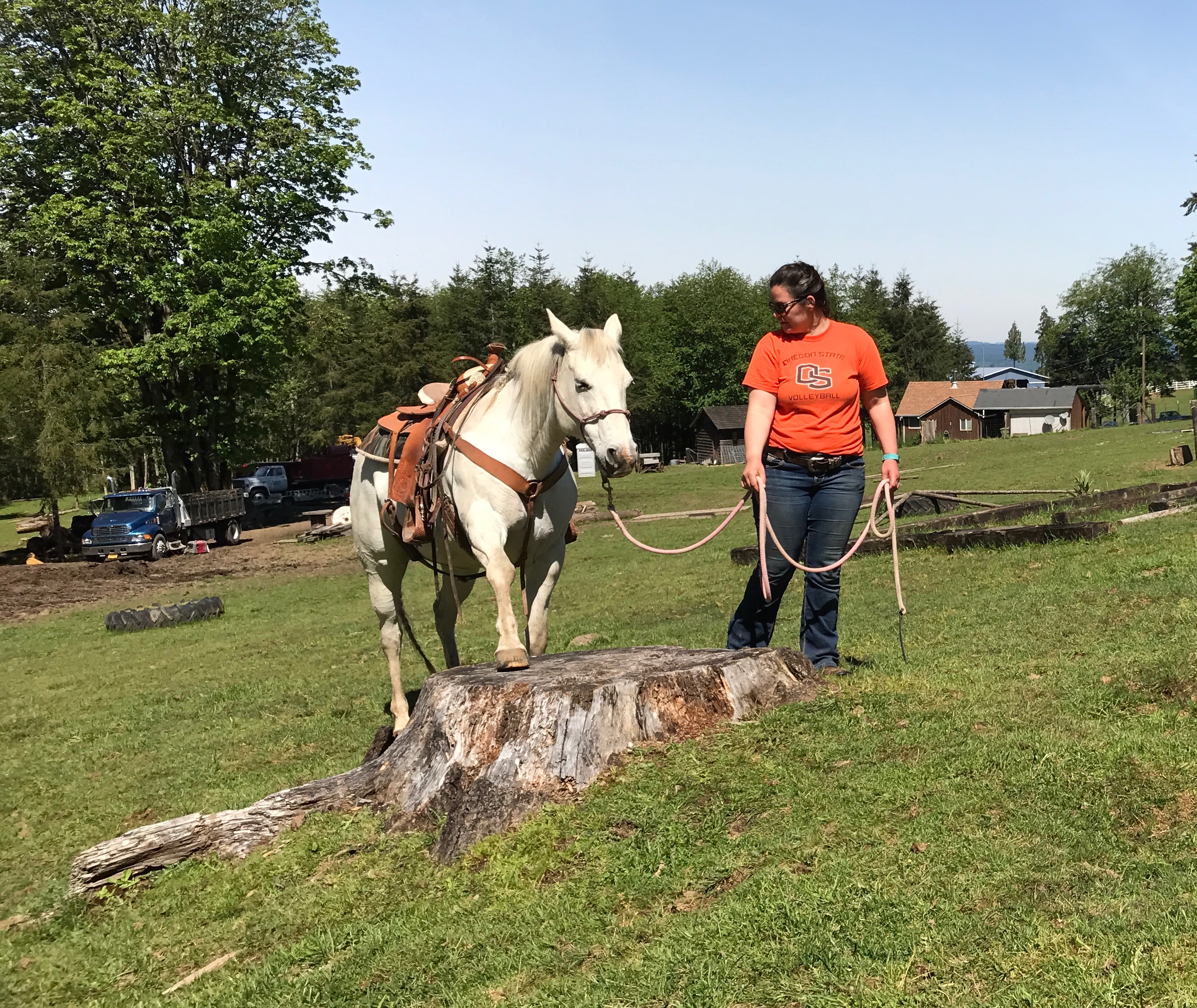My Personal Thoughts
Journey to Wisdom.
_____________________________________________________________________________________________________________________
You can check out my most recent thoughts and insights at my Get Grounded Equine Facebook Page.
__________________________________________________________________________________
Quiet Intuitiveness
March, 2018
Performing a technical maneuver or task with a horse bears a uniquely layered complexity that takes time and practice to develop. The first layer involves understanding how the physical parts of a horse work in conjunction with how our bodies can move in a synchronized way together. The next layer involves building rapport, confidence, and positive motivation that keeps the two dynamically together. The last layer surrounds the necessity of effective communication. Sadly this last layer, the communication factor, has been sorely misunderstood with one member (the human) doing too much talking (directing) and not enough listening.
Comprehensive 2-way communication is the most honorable, rewarding and successful way to be with horses. All of us need to improve our intuitive, listening skills and become more aware that the horse has voice. No they don’t have a language symbol system, but they are communicating. Most of us have fairly refined skills in directing, demanding, and commanding. But the conversation is weighted with our goals, our words, our thoughts, our emotions, our egos. In this lopsided communication dynamic where horses end up being ignored, I see horses choose 1 of 2 modes of response. They either become subservient and robotic allowing the human to emphasize themselves or they express frustration by argumentative behavior. The robots endure the whole interaction, go through the desired routine without protest and have learned it will be over at some point. The argumentative ones are expressing frustration for not being heard leading to a desire to escape, to disconnect.
Using voice cues needs to be minimal and consistent. It is very difficult to be effective at listening if you are talking too much. Your non-verbal skills have more potential and power to connect and synchronize with your horse. The reasons for this are two-fold: one being the horse is non-verbal dominant and the other is our poor ability to listen to non-verbal language and feed-back when we are engaged in speaking words. This poor ability to pay attention to other things while speaking is why we have laws against talking on the phone while driving. I know myself, when talking on the phone, I am compromised at paying attention to what is going on around me. When in task mode with my horse, I keep verbal minimal and only use 1-2 word phrases with specific tones. I believe phrases longer than 2 words or a bunch of sentences causes us to get too caught up in ourselves and just becomes white noise to the horse. I have words I use in conjunction with my requests to my horse such as: 'back', 'come up', 'walk on', 'over', 'ho', 'get around', 'side'. These words are taught first at eye level, in hand making a connection for learning the cues when under saddle. I have words I use that help bridge my request to their response. Example words for this would be: 'yes', 'no', 'quit', 'thank you', 'good'. The words I use are used precisely, consistently and in conjunction with my body and aids. That way, once the horse becomes consistent and reliable, the mechanical aids can be used in a very subtle and quiet way.
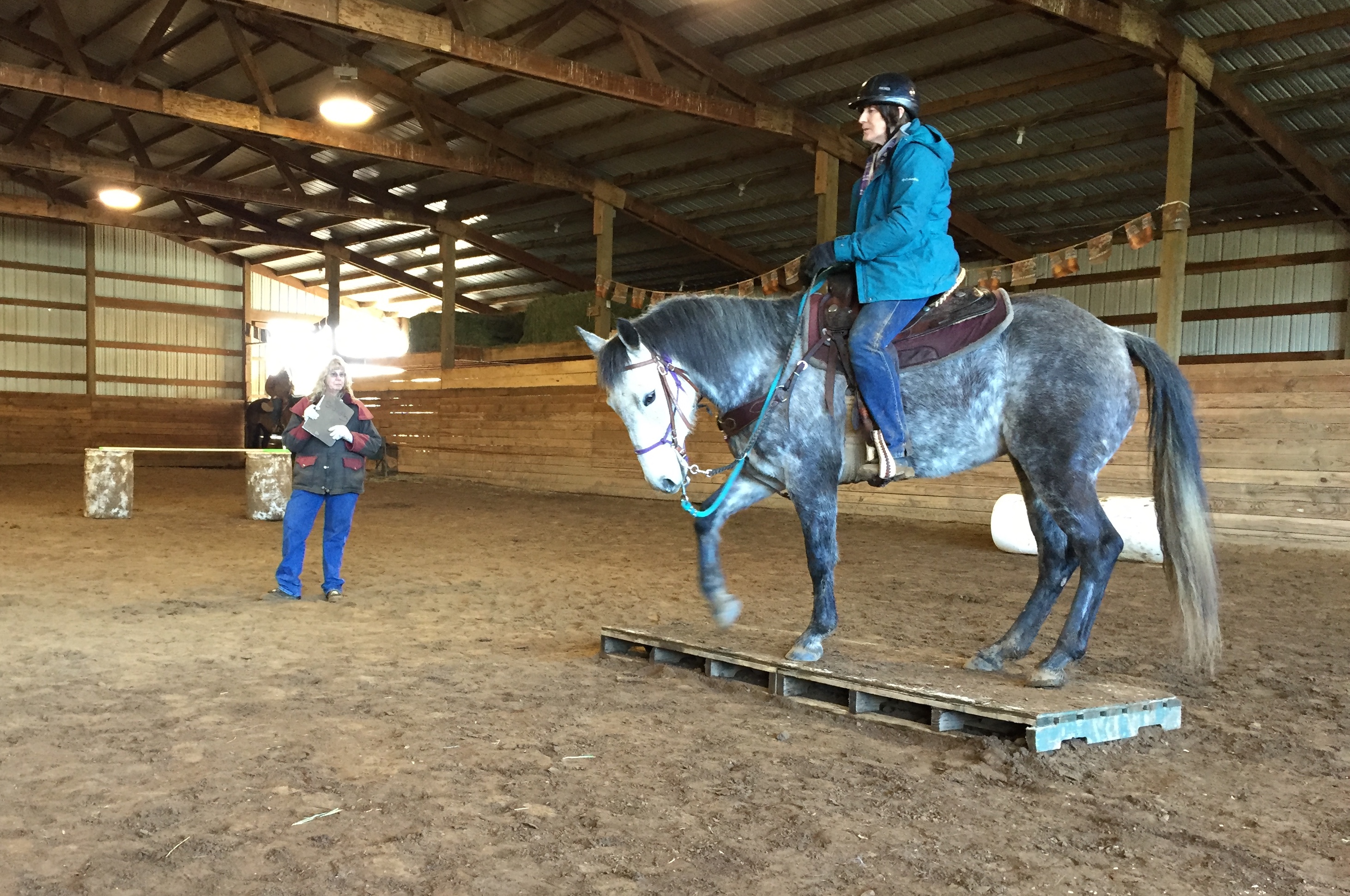
___________________________________________________________________________________________________________________________________
The Dazed Handler
Who is really being desensitized?!
February, 2018
When you have a method that gets the results you are looking for, it's understandable why you would continue in that method even if it has not been fully analyzed. Too many trainers and handlers adopt methods purely based on performance goals, weighing their training choices too heavily on the immediacy of a moment. Very few take the time to consider they are working with a sentient being who has opinions, emotions, and thoughts on them and the experiences that are created for them. Shifting to a more holistic relationship based mindset calls for each training moment to somehow fit into the wholeness, the bigger picture of the horse/human relationship you are trying to develop. So many handlers and teachers have become dull, desensitized to their disrespectful, irritating and rude behavior towards horses. All the while, these methods are sold as a better, kinder, more 'natural' way.
Recently, I watched a video tutorial of a trainer showing a method for teaching a horse to move laterally. The video was spot on for showing body position and mechanics necessary for the maneuver. The handler had a very good understanding of what parts of the horse's body he needed to solicit. Sadly, he had very little awareness of his own body, keeping fairly static with most of his energy and movement extending to his aids. In comes the 4' stick. Yes, he had that old reliable fiberglass rod, the one marketed to keep you out of kicking range and yet still 'allows you to relate (?) to your horse'. The aid was used in a rhythmic, vibrating motion sometimes physically tapping on the part of the horse that was expected to yield. The use of the aid remained constant in its action and the horse stopped yielding once the aid stopped.
The concept showed a horse learning the tapping, the irritation would stop once they yielded their body in the desired way for a period of time. It was clear that a high amount of reliance and attention by the handler was on his aid. It was the most dynamic thing in the scene with the handler's body being rather dull and mostly static. For me, I strive to use my aids as subtly as possible, keeping my body participating in a meaningful dynamic way. The #1 goal is for the horse to gain a mindset of 'we are moving together', looking for synchronicity in movement and thought. Flowing and moving together is much more meaningful than one being static while the other 'jumps through the hoops'. The aid should be considered a bridge to understanding the communication of the body. It should only be used as a back-up of what the handler's body is saying. When the horse consistently responds to the body, the aid is disengaged and, eventually, goes away completely.
Horses are naturally paying attention to movement, foot fall, leaning, and position. If you create a method that is consistent in assigning meaning to your movements, the horse quickly catches on. Horses move together more often than they pressure each other to move away or yield. We all need to pay more analytical attention to our actions, body language, and use of our aids with an empathic approach, meaning we put ourselves in the horse's hooves to gain better knowledge of their perceptions of us.
Think about guiding them more than pressuring them.
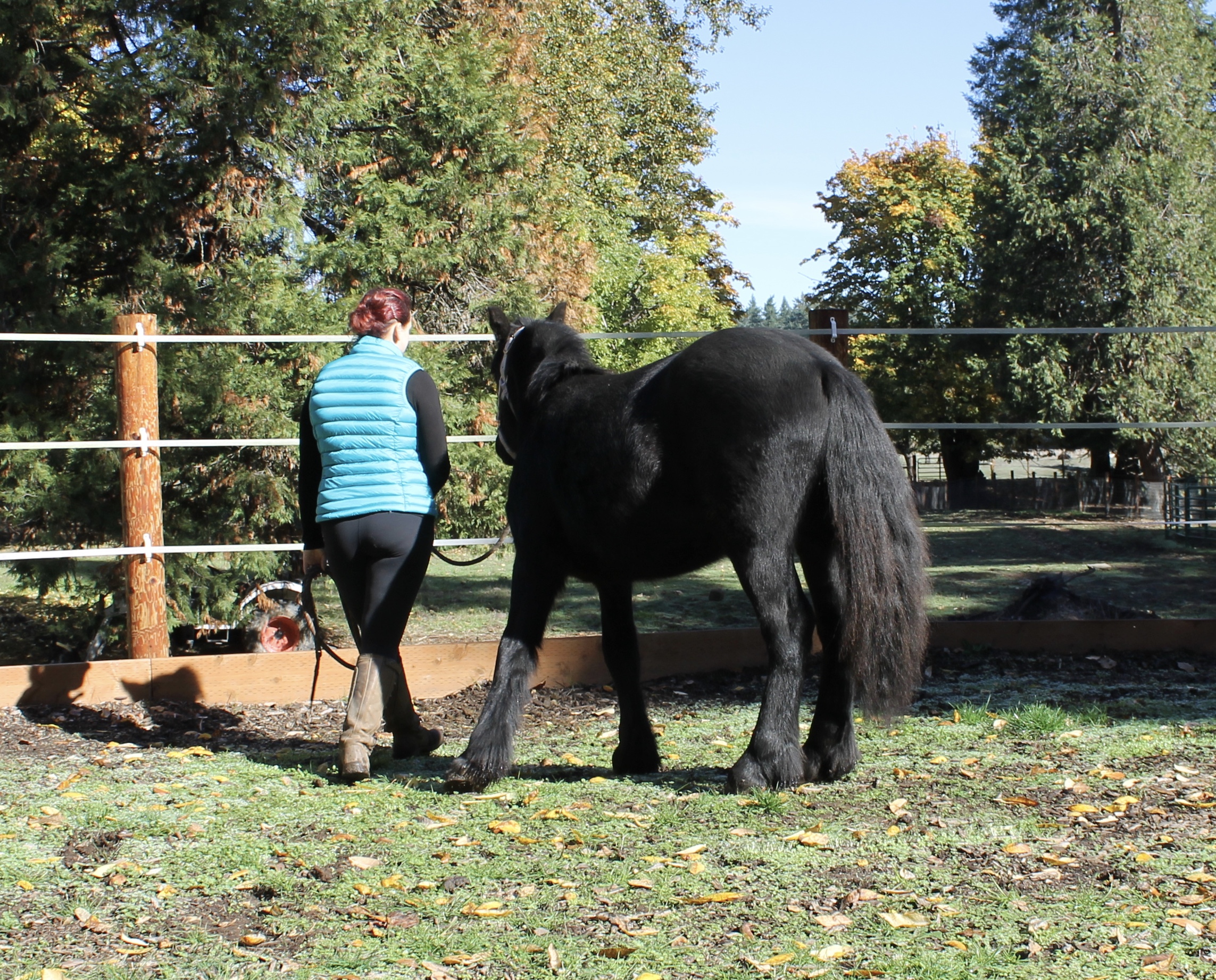
Teaching shoulder yield by the concept of 'moving together'. Lead rope is loose and only makes contact when necessary.
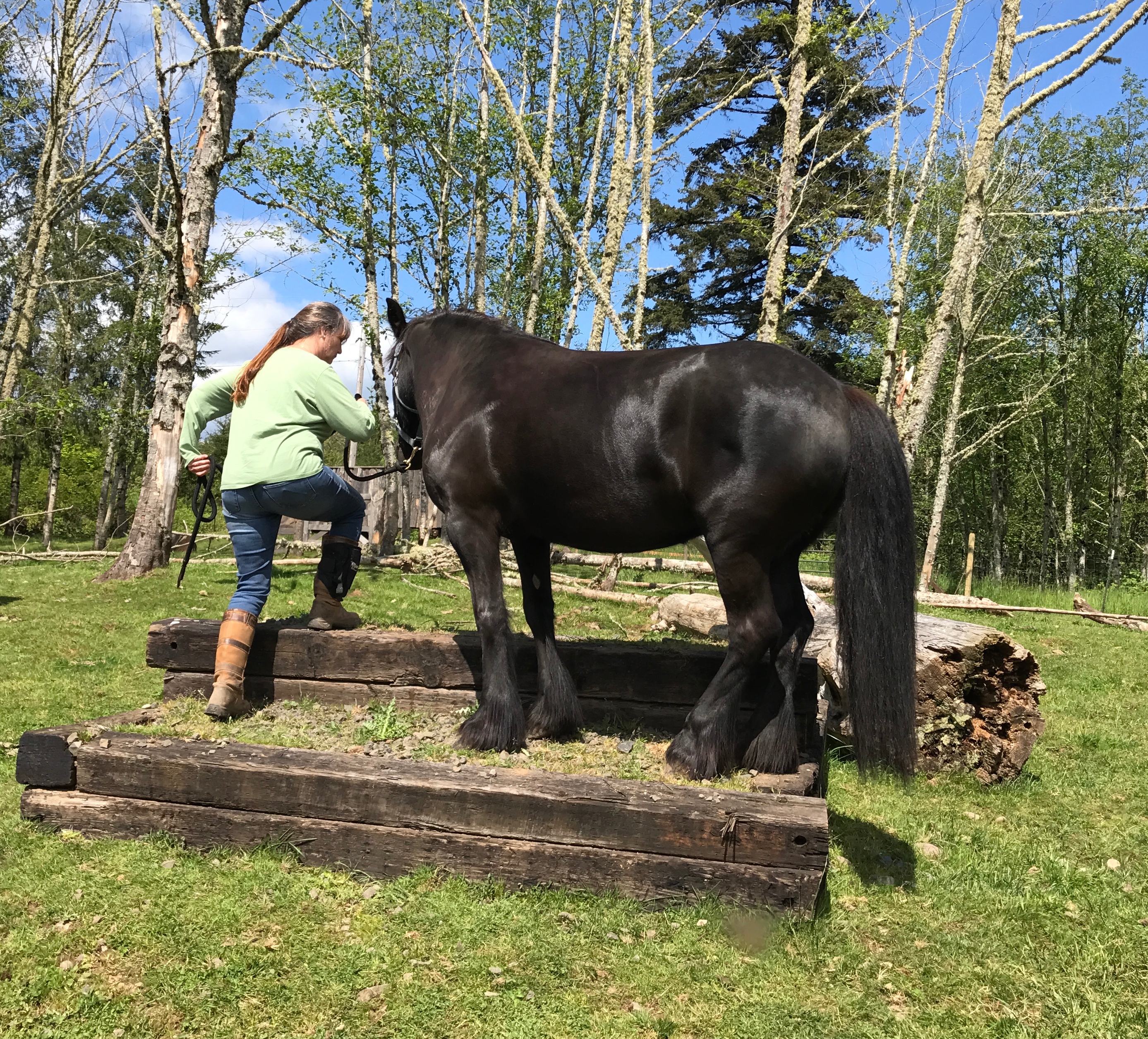
Using the yield concept to assign meaning to the request. Again, lead is loose with reliance on body to guide the horse and move together.
The light horse is changing direction and moving off the guidance of the dark horse.
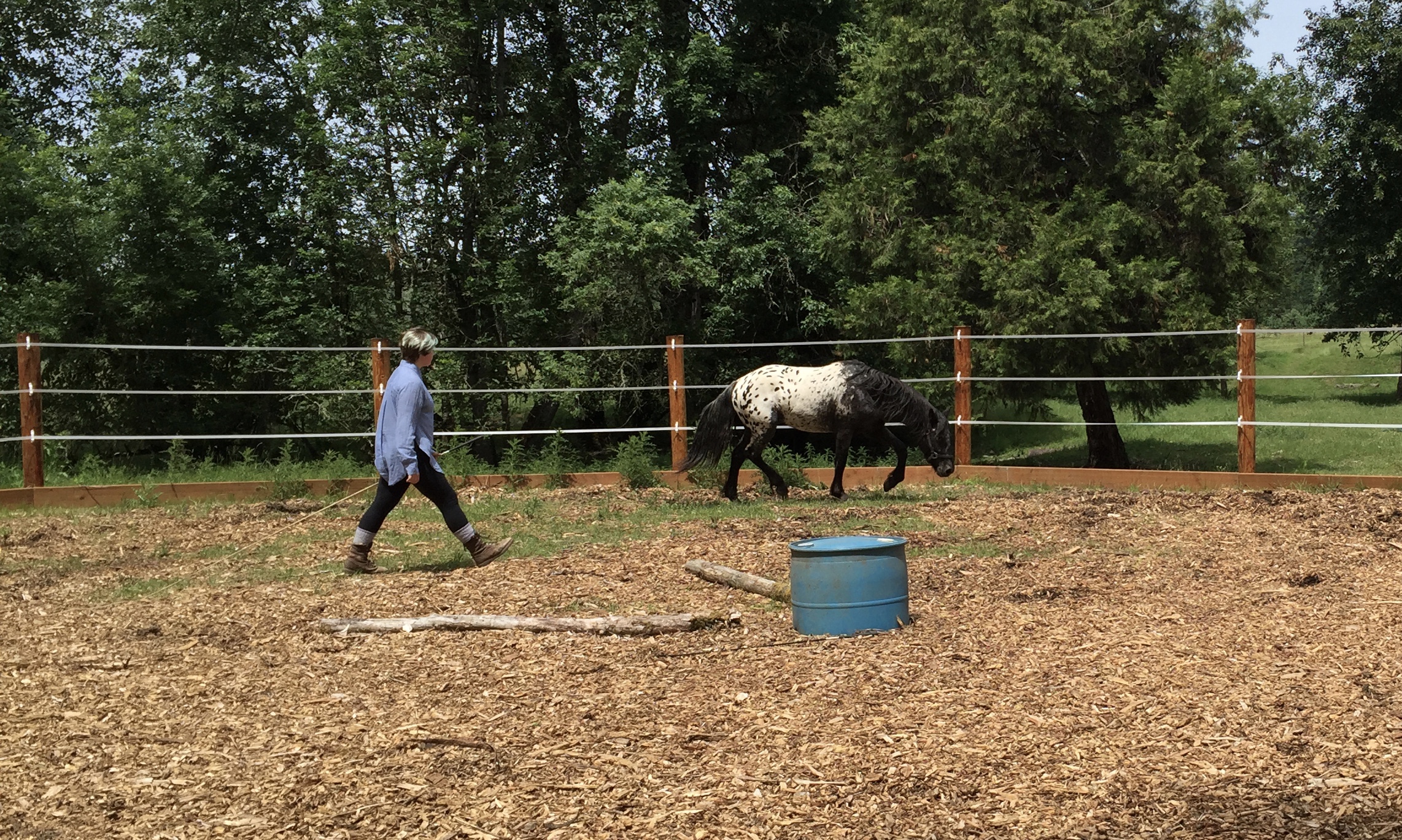
Both moving with aid disengaged.
__________________________________________________________________________________________________________________________________
Analytical Skills
The value of acknowledging sentiment.
January 2018
The dominant trend found in human/equine relationships center around a Solicitation - Response dynamic where Solicitation is weighted with the human and Response is weighted with the horse. Mainstream horsemanship tells all of us that it is perfectly normal and acceptable to solicit and expect response without question or dialogue. Most methods are solicitation focused failing to teach or emphasize the most important part of authentic horsemanship. I'm talking about the significant part of horsemanship that shows well developed, analytical skills that only come when we acknowledge horses are sentient requiring us to accurately recognize their sentiments. Hence we have a huge number of equestrians, trainers, clinicians who are 'experts' of a method (the process of solicitation) but have very little understanding of the process of response. With response, most only have patience for the horse to respond in the desired way. So many short change their experiences by choosing to ignore the conversation the horse is trying to have with them. To take it a step further, we find humans atrophied in their knowing of what a horse solicits or says.
Doubly troubling is the teachings of incorrect interpretations of response. The prevailing mind-set is there is an ongoingbattle of the wills, that we have to establish dominance, that there is hierarchy and we have to be the 'lead mare'. It's more common for people to interpret an undesirable response as disrespect, laziness, testing, or some battle of the wills rather than lack of bonding, relationship, or understanding. For too many, undesirable responses trigger frustration, anger, embarrassment, fear, and disappointment. Quite often, these emotions limit one's ability to be creative, solve problems, and have good conversations with their horse. In comes the temptation to up the severity, the use of the aids and mechanical force.

This mare could not wrap her brain around her first creek crossing. She even struggled with the example of following her equine mentor. She emphatically told us, "No, I can't do this". For many, moments like this bring temptations of being forceful and using aids that put on the pressure. We decided to take the time to figure out what would keep her focused and engaged in the task as well as build her confidence.
___________________________________________________________________________________________________________________________________
Utilizing Herd Focus
Working with multiples and using the nemesis to your advantage.
December 2017
Some time ago, I had a client receive a very narrow minded comment from a clinician who noticed insecure resistant behavior with her mare. It was the mare's first event; a clinic with lots of other horses, strange obstacles, and quite a bit of activity going on. Naturally, the mare was compelled to keep track of the two mates she was familiar with. At one point, she became overly focused on getting to her mates, rendering her mentally unable to attempt the task that was being asked of her. Out of ego and arrogance, the clinician stated to her that, "A horse is not broke if it can't go out alone".
Certainly the dream of every horse owner is for their equine to perform and be relaxed regardless if they have their mates or not. Developing a horse towards independence is always part of our foundation goals. Traditionally, most trainers start their horses cold turkey on isolating the horse during training sessions. This may teach a horse how to work in a controlled isolated environment without others. But it does not help the horse to build confidence and independence from others when thrown into a group scenario. A more holistic approach involves the trainer working green and experienced horses together at the same time. In the beginning, for the green horse, the presence and examples of others helps minimize stress, as well as enhances the development of understanding. As the green horse progresses through his/her days, strategies are designed that encourage less reliance on others. The more experienced horses help the green horse to understand the patterns of the daily routine. In those patterns, over time, the horse learns and understands times of being separated are not infinite.
Strategies for helping a horse understand the concept of sometimes being apart needs to happen slowly and gradually over time, months or years for some. Sessions involving separating and reconnecting should start out in familiar environments with activities that are already understood. Gradually more complexity such as a new trail or an event like a clinic can be introduced. The key is to make sure the complexity matches the mental ability of the horse. There is annoying herd focused behavior and there is dangerous herd focused behavior. You never want to overwhelm a horse to the point they become unsafe or mentally unstable.
Building a relationship with a horse that is willing and comfortable to head out with you alone takes time. The more you ask them to separate from their mates, the more you need to be there for them intuitively, mentally, and thoughtfully. The road to confident independence is a journey and something that needs to be maintained throughout the life of the horse. The clinician in my story was focused on the horse accomplishing a task rather than helping my client brainstorm strategies to build the mare's confidence and ease her concerns. Using one of her mates to help her experience the task would have been beneficial.
A herd mate helps keep things relaxed during first mounting.
Using an experienced horse to guide a green horse through an obstacle experience.
A mentor horse stands quiet while a green horse has her 3rd ride.
___________________________________________________________________________________________________________________________________
A New Approach: The Circle
November 2017
The word 'lunge' refers to a sudden thrust forward, often related to an attack or intent to seize something. With horses, for most people, the practice of lunging a horse is about making the horse move forward through the different gaits. The reasons for lunging vary. Some believe it teaches respect, others want to get the horse warmed up or blow off excess energy, and many find it helpful to determine if the horse is sound and balanced. So many just do it and really haven't thought out their goals or why they are doing it. They get awed by and want to look like the big trendy trainers who stand stationary while a horse mindlessly runs around them. Then there is this popular repetitive method of sending in a direction, driving them forward, disengaging the hind, turning and sending in the other direction. I have seen some pretty well known owners of 'methods' offer lunging as a session of drama, demanding frantic energy, smacking a 'stick' or whip around with all this body language of 'do it, do it now!"
Traditional lunging is not a big part of our program, in fact.......almost non-existent. But we do work in a circle both on a line and off in a round-pen. Our goals are 4-fold: focus, synchronizing/moving together, developing 2-way communication, and preparation for line driving. With these goals, we find keeping ourselves quiet and body focused is very important. Horses have a very refined, automatic ability to pay attention to the movement of another and synchronize with that movement. For them to do it with us, we must focus equally on what we are doing with our body and how they respond with theirs. Horses effortlessly move together with each other. A similar connection and synchronicity can happen with us if we tune into that, pay attention and speak consistently with our bodies. Many follow the myth that 'connection' is evident when a horse obeys and complies. Too many people take a dictator stance and mindset, not being active participants in the movement or navigation. This approach is often too heavily reliant on mechanical aids and is lack-luster in the sense of authentic connection.
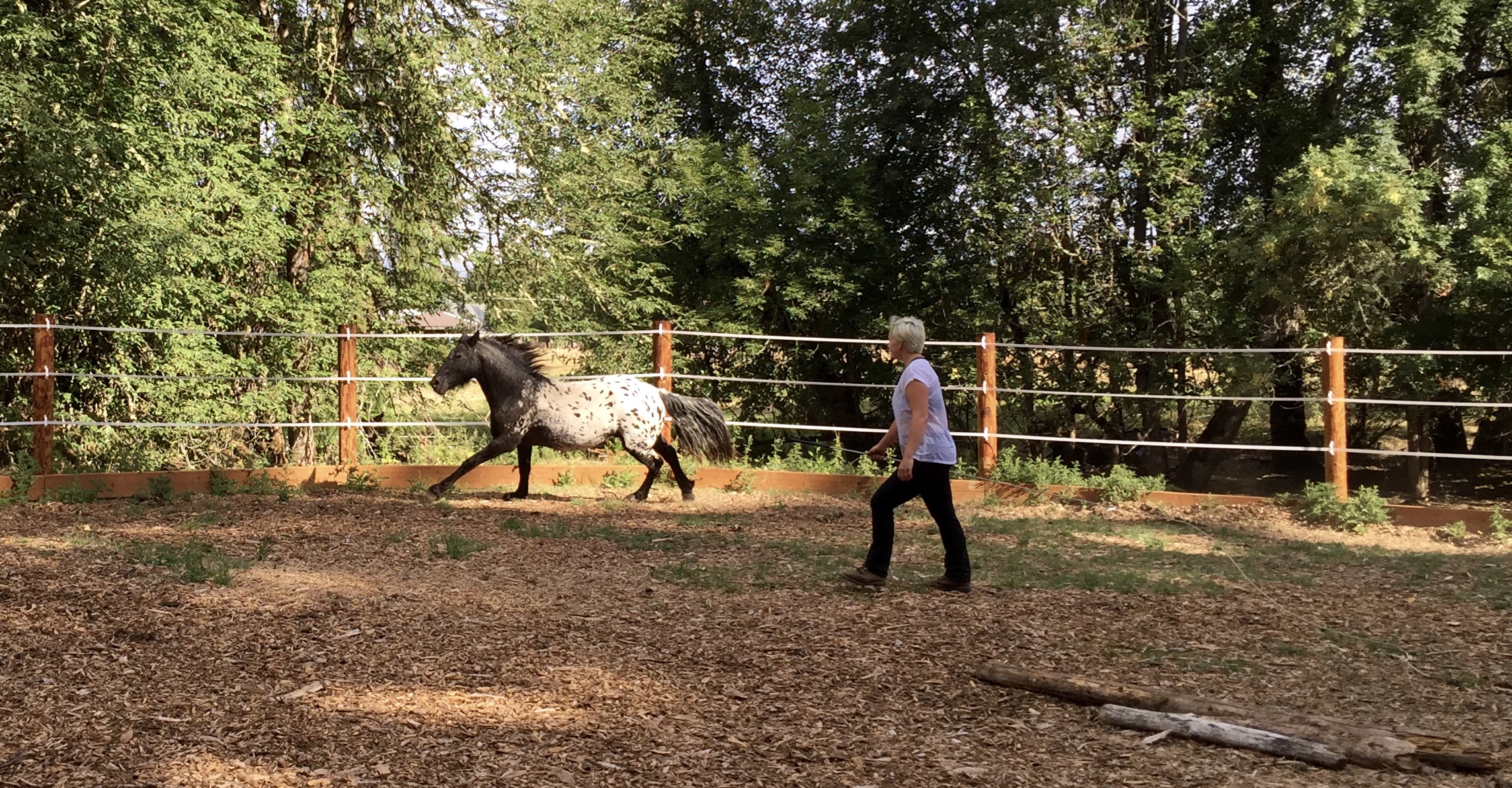
In all three photos, you can see the person is dynamic in her movement. All three show a specific body language, position to the horse, and movement that says, "Let's go forward." The handler is moving in line at a diagonal from the inside hip of the horse. The aid (whip or end of rope) is minimal and stays disengaged until the horse loses synchronicity with the handler. It is only used to back up what the body is saying, then immediately gets disengaged when synchronicity picks back up.I see so many people lunge with their whip constantly engaged and/or popping at the horse, even when the horse is doing what is asked. If the horse is doing what you want, why would you keep putting on pressure? The same thing bothers me with dressage riders who repeatedly spur their horse when the horse is already performing the task. Eventually, quite often for us, the aid can completely go away. Because we rely on our body to speak, we have never needed a whip for line driving.
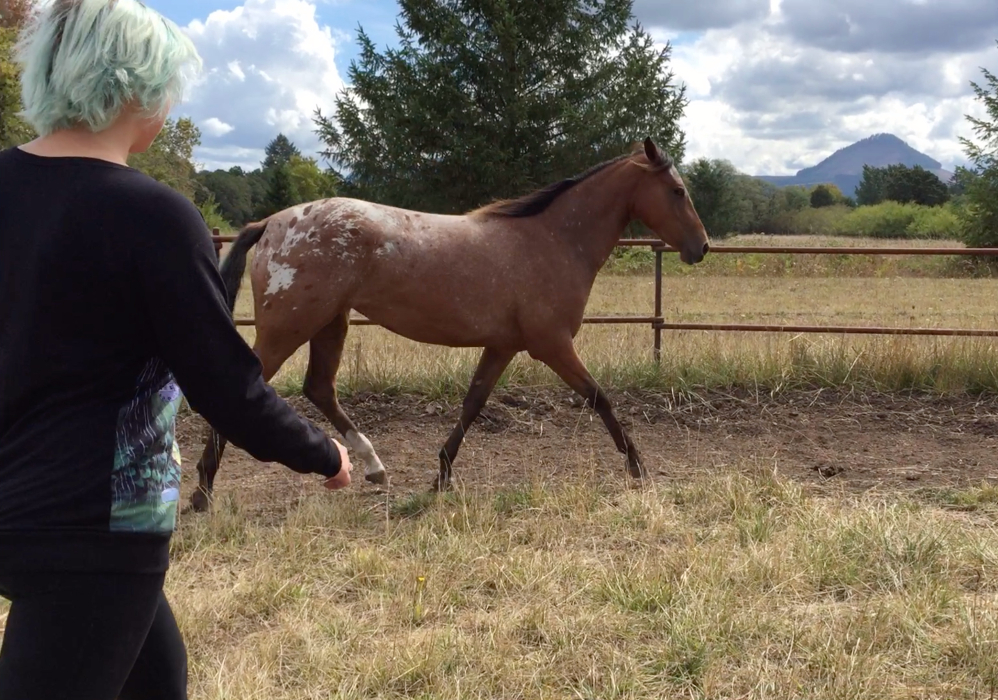
Working in the confinement of a circle should never have a militant air. It should be a place to have a conversation and to figure out 2-way communication. Each horse has an individual communication style and working in the round should be a non-threatening way for horse to learn to both listen and speak, to begin understanding NAVIGATING TOGETHER.
__________________________________________________________________________________________________________________________________
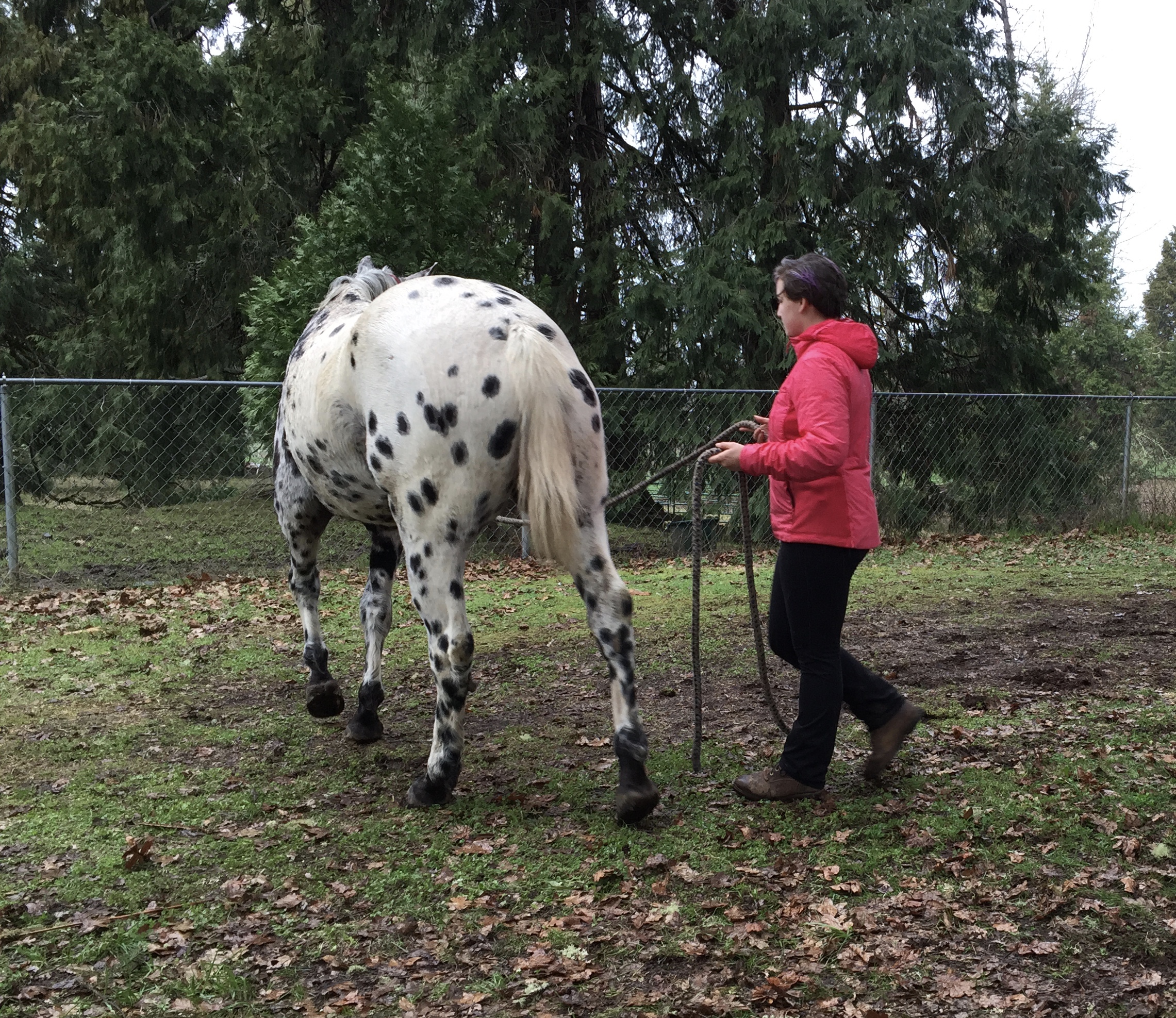
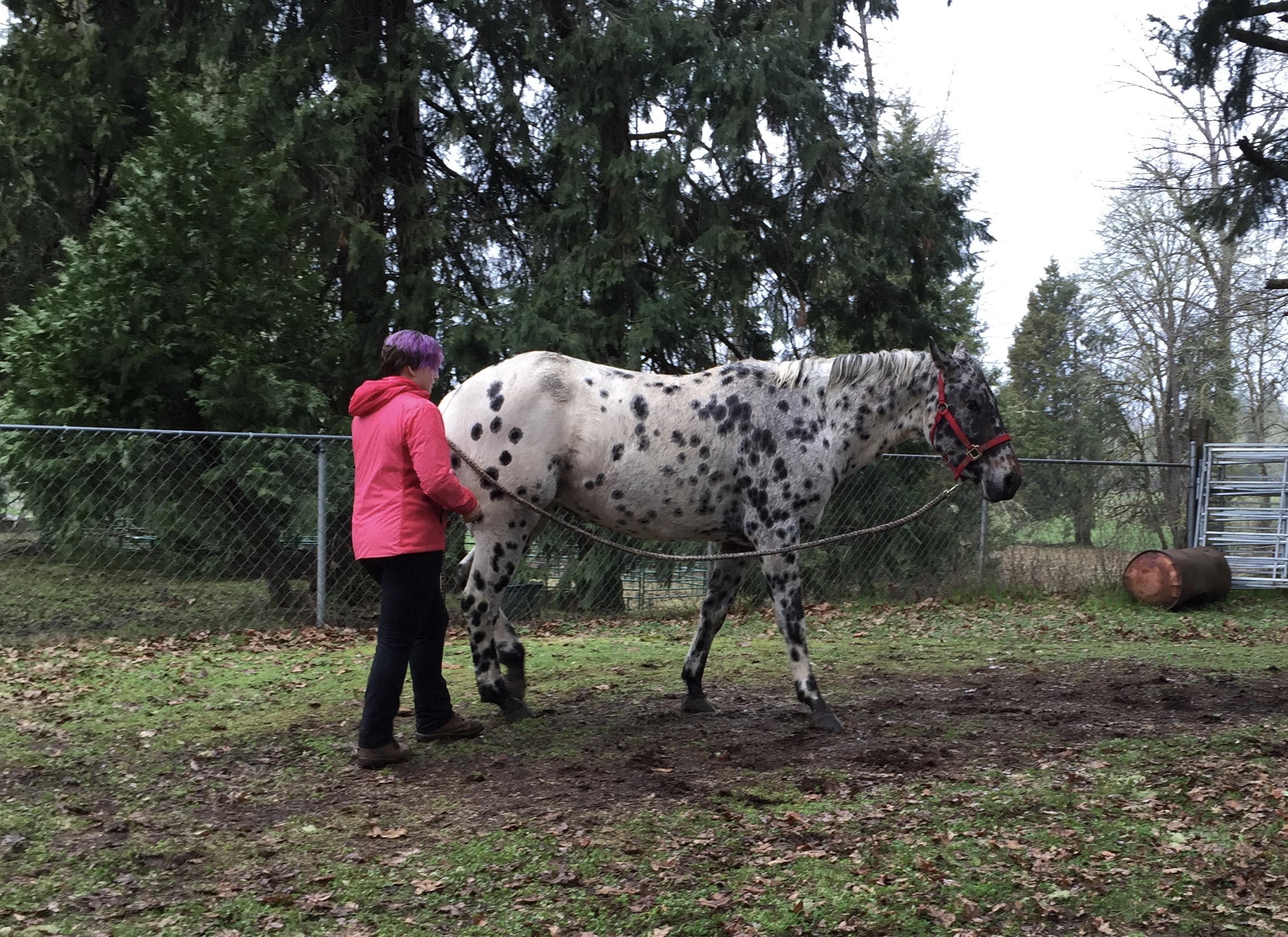
These two photos show the linking step between moving at the hip in a circle to single line driving. When the horse is ready, we add the second line.
Levelheadedness
October 2017
The myth of 'gaining respect'.
Sometime ago, I lost count of how many horses we have taught to navigate open air on trails and through the woods. Happy to say, all of them successes with very few instances of unsafe misbehavior. There is a popular method/myth out there that misbehavior should be regarded as disrespect and always handled in the same manner regardless of what caused the misbehavior. The complexity of navigating on trails is not for the faint hearted or narrow minded. It involves a measurable understanding of body mechanics, communication (talking & listening), safety, awareness, intuitiveness, and thoughtful behavior management.
Horses want peace and want to work together. Horses are more concerned about understanding, feeling safe, and heard rather than having some kind of ego trip with you. So, when they misbehave, they are telling you they are concerned about something and need help with their confidence and understanding. Because we are thorough with our prep and development of our trail mounts, it's rare we have out of control misbehavior. But a misbehaving moment, first and fore-most, should be a moment where we listen and develop a plan to help the horse relax, understand, and engage in thoughtfulness. I have never felt or thought a misbehaving moment would be solved by 'lunging for respect' or any kind of 'move their feet' strategy. I do not believe these strategies lead to a more thoughtful horse and they really can't provide a way for the horse to better understand or find resolve. In fact, I would argue that frantic lunging in tight circles can lead to turning on more flight brain than thinking brain. Not to mention, many trail/terrain scenarios would be completely unsuitable and unsafe for this kind of practice.
The arrival of a consistent levelheaded horse is reliant on a handler who has developed intuitive skills of listening and knowing what the horse needs, can creatively strategize engaging curiosity, relaxation and understanding. We have found incredible success with working at eye level hiking and using obstacles/tasks as a way to establish a solid foundation. Dictatorship methods often give the handler permission to be disrespectful and underemphasize the importance of creative thinking.
Relationship based navigation can result in a level of trust & understanding beyond the imaginable.
___________________________________________________________________________________
Bonding
September 2017
Building the relationship first.
On the day of my birthday in August, I had a significant visitation from a turtle. It was sitting in the middle of the trail just waiting for me to show up. A few weeks prior, I had another turtle before me, under water just as I was about to cross a creek. I consider them both, especially since they were first time encounters, a significant sign that I needed reminding to take things slower. This prepared me for the work I needed to do with 2 horses, a mare and her 4 month colt. Both hold a temperament that many would find very difficult. I'm usually able to find a way to connect and engage with any horse, but these two just didn't seem interested. As a matter of fact, they gave off a lot of signals that they didn't want to have anything to do with me. They were both skeptical, did not want to be touched, did not like me moving around them (even if food was involved), and not responsive to the standard methods of drawing curiosity.
The mare questioned every new thing I proposed, even if I broke it down into tiny little bites. I knew I needed to find a way to bond and build relationship before she would be willing to enter a learning mind-set with me. I decided to try something that I actually saw her as a mother do with her newborn foal, surround and isolate. I know that sounds odd, but I remember watching her and other moms circling their babies when other horses came around. I also saw her rounding her baby up and herding him away from the others. It's like this dance they do of 'focus on me', until the baby bonds.
So off to hiking we went, just the mare and I. Usually we hike young, green horses with others to keep stress low. But this mare is very independent and secure in herself. So I have been loading her up by herself and we have been putting in the miles at eye level. The miles I have spent at eye level on trails with horses is beyond counting. There are so many things to be learned, skills to be developed by this practice. But, with this mare, clarification came about bonding and building relationship. I'm now getting a soft eye, eye contact, and curiosity.
Navigating at eye level with a horse is one of the most meaningful things you can do. Emma and I stop to investigate what she is hearing on the the side of the trail.
__________________________________________________________________________________
The Right Aid at the Right Time
August 2017
Why I don't start a horse with a bit.
When you are more focused on learning rather than forcing or controlling, you make more thoughtful lesson plan choices. Horses don't come to us knowing how or what to focus on. It's very easy for them to focus on their bodies/movement as well as the body and movement of another. When starting a horse, I want them to first learn to focus on my body, my movement, my footfall. If they get that down (which they all do very well), it becomes easy for me to teach them a huge part of what they need to do with their body and movement. So I start out with halter and leading exercises, moving to side-pull and sending exercises, finally to driving exercises. Introducing the bit during any of this taxes the horse's ability to keep the focus where they need to. I consider adding the bit when I start to feel I have understanding, that the horse can do basic responses and focus on my body. This process usually takes place over the first 30-45 days with bit being introduced somewhere around their 8-10th hour of riding. Because I do extensive ground driving before saddle, horses have a very good understanding of leg and rein.
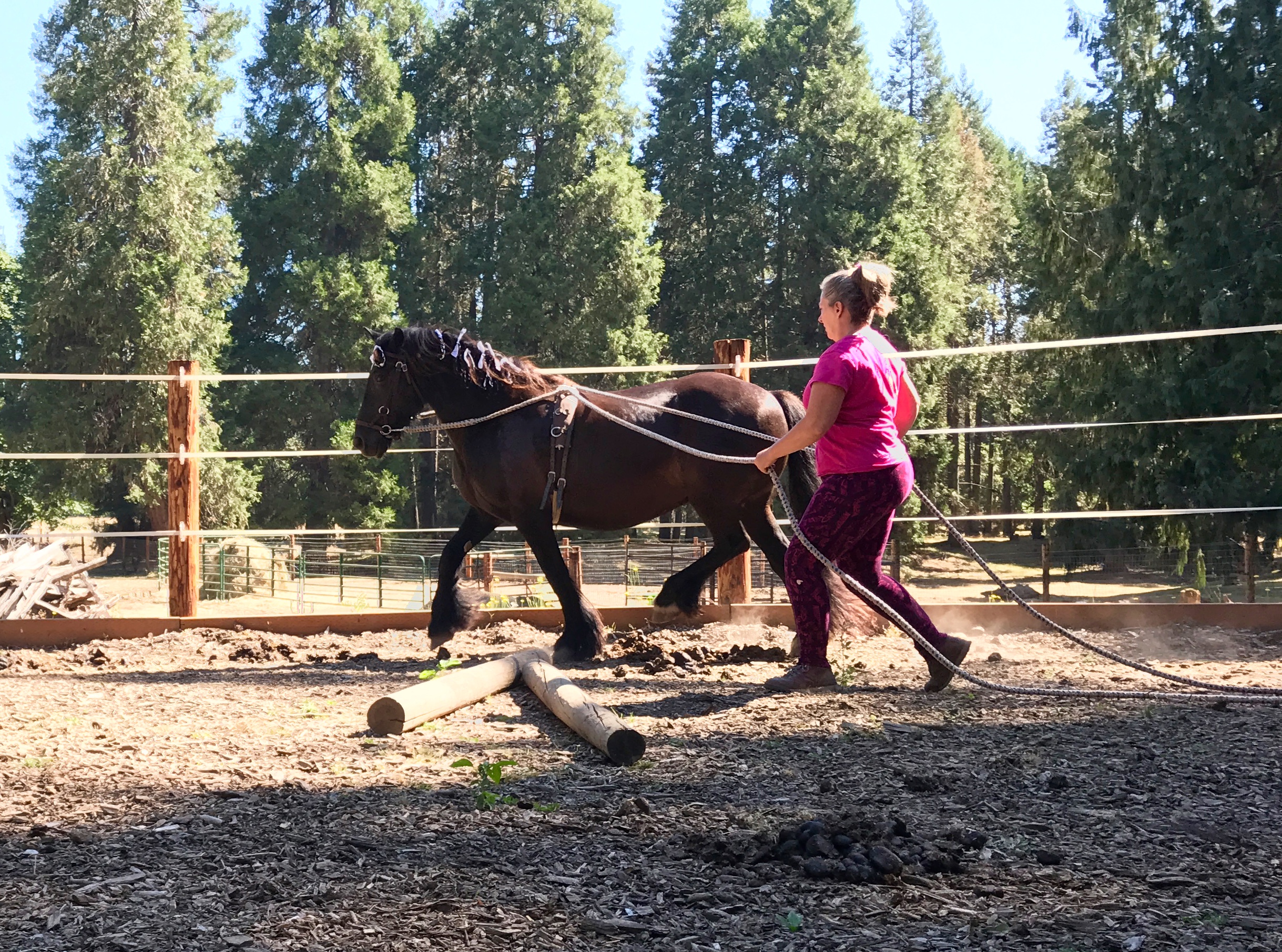
Jan is moving beautifully, light and responsive without the distraction of a bit.
___________________________________________________________________________________
Get A Grip
August 2017
Your horse would really appreciate that.
Respectful horsemanship requires one to be consistent and able to manage their emotions. It's all too common that people expect their horses to be in control and perform without drama or confusion. Yet, they themselves are out of control, unpredictable, and emotionally all over the place. Quite often, I see horses quietly screaming for their partners to be more self-aware with very few really listening to their suggestions. So the struggle continues, with folks blaming the horse for what's not going well.
Managing emotions is a skill and takes practice. Building this skill with your horse often takes a 'slow it down' approach, where you simplify your time together starting with basic communication and building from there. Getting out of the saddle and working at eye level is ideal. It lowers stress for both of you. Take the time to shift your focus from a performance mindset to more of a 'let's explore and discover together', 'let's navigate together'. It's a time to ask the 'I wonder if.......'.
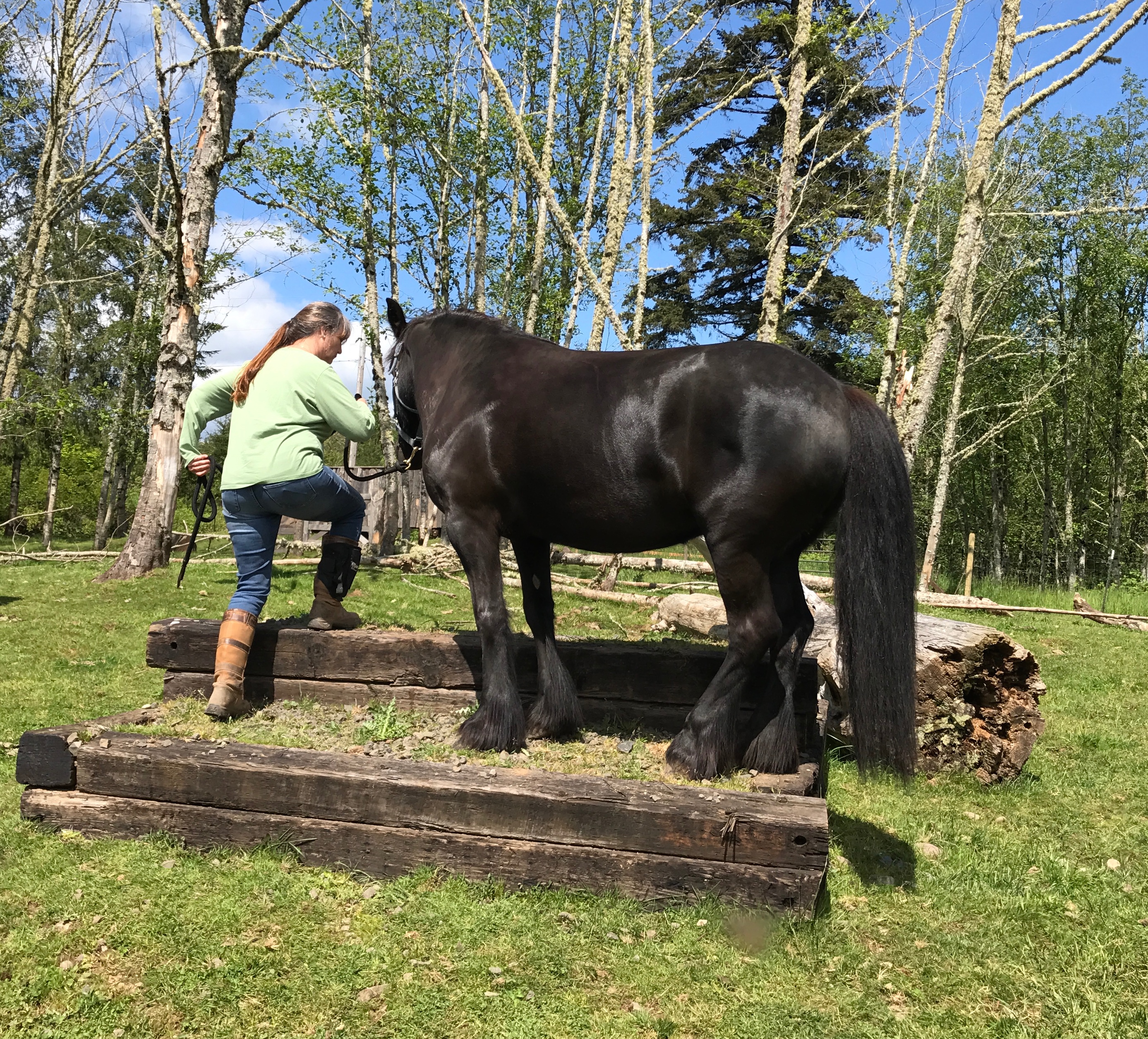
Solving problems together by navigating an obstacle at eye level is a great way to minimize your stress.
Being at eye level makes you more of an active participant in the task and provides opportunities for you to focus on problems solving rather than just being emotional.
____________________________________________________________________________________
Eliminating the 'Good/Bad Horse' Concept
July 2017
Reshaping our Perspective by Shifting Our Vocabulary
For almost a year now, I have been trying to unravel within myself a mindset that is so mainstream, so firmly held in equine circles yet so detrimental to genuine relationships with horses. The mindset comes from a long hauled myth that horses should be subject to our judgement and criticism. I see this mindset manifest on a regular basis most evident by the words we say to our horses and about our horses. The cycle of interaction is well known: we make a request (some make demands) and expect a specific response. If horses respond in a manner that pleases or satisfies us, they are considered 'good'. If horses respond in a manner that is not desirable, something we didn't want, that is considered 'bad'.
It's so easy to fall in the trap of self-importance when interacting with our horses. If they please us, they are good. If they disappoint us, they are bad. When on a journey to find positive, meaningful interactions with horses, sometimes you have to abandon the popular myths. My words both shape and reveal my perceptions. With these revelations, I have been trying to keep myself minimal on the judgement, the criticisms, that stem from my desire to be important. What is the first, most evident thing that needed to be unraveled within myself? Using the words 'good/bad, boy/girl' and 'good job' needed to take up less space in my mind. Instead, I have been embracing words that keep me in a frame of mind that focuses on gratitude, encouragement, and respect.
Remember, willingness comes from rapport and understanding......not from our judgement.
'Thank you' shows gratitude.
'You can do this' shows encouragement.
'I understand your concern' shows respect.
These are things we should tell our horses everyday!
___________________________________________________________________________________
Stress Management
June 2017
A Key to Learning
Well, first you have to realize that YOU are a source of stress for your horse. So many get focused on the actions and behaviors of the horse with very minimal ability to engage in self-awareness. As trainers in the practice of showing horses about life with humans, it's important for us to maintain an awareness that new experiences are stressful. This kind of awareness should exist with all who interact with horses. That way, it becomes more important to form strategies for minimizing and managing stressful situations. Be aware of ALL of your actions and never assume your horse will blindly understand. Be a thoughtful communicator to your horse by using good articulation and listening skills.
Teaching experiences with horses are more of a creative process than many realize. What is brought to the experience needs to be custom tailored to the horse with great consideration for their temperament, their curiosity/skepticism scale, and their way of processing perceptions. It's important to keep ongoing mental notes of what they do and don't understand. When I walk into a teaching moment with a horse, especially if it is one initiated by me, I stay focused on having the proper teaching tools and providing the proper learning environment. Knowing and finding what is PROPER must involve an attentiveness to the horse, and an intuitiveness to understand their feedback. Holding true to the above stated philosophy has produced a program that is virtually explosive and drama free with a genuine sense of connection between us and the horses.
Over the last 4 years, my awareness of the stress on horses associated with training has become more refined. The horse session is usually a success if I prepare my lesson with most of my thought going towards engaging curiosity and minimizing stress. Often, a mistake most trainers will make in a session is not allowing time for processing or time for gaining feedback from the horse. They go in to the session with a rigidity to their agenda. When things go bumpy or there is conflict, it is summed up as disrespect rather than lack of understanding, lack of confidence, or lack of peace resulting from too much pressure.
When I have a horse that seems confused or lacks confidence, I begin changing the plan immediately catering steps towards building that understanding. Quite often it involves taking the chunks of my suggestions and breaking them down into smaller bite-sized pieces.

__________________________________________________________________________________
Precise Body Awareness
June 2017
Through teaching others, I have discovered many handlers are more comfortable riding their horse than they are at eye level with their horse. Quite often the lack of comfort and confidence comes from a limited understanding of just how aware & precise a horse can be with his/her body position & movement. So let me emphasize here, horses are very aware of their bodies, where their bodies are in space, and their movement. They have quite impressive abilities in keeping tabs on the position of their bodies in relation to other objects (moving or stable). Through hours of obstacle/task based training, at eye level and under saddle, my understanding of 'connecting the dots' for us and for horses comes through this significant body awareness.
The Puzzle Piece Concept
Many of the tasks we ask our horses to perform require the horse to position and move their bodies in a specific way. Working at liberty, both at eye level and under saddle, requires a refinement in communication with body gestures/movements and physical position in relation to the horse. When the horse knows we are in task mode, they understand gestures and body positioning are calling for a response on their part, a specific response. I call this the Puzzle Piece Concept. Anyone who has engaged in a jigsaw puzzle knows that each piece only fits in one place and one way. This kind of mindset can apply when we are making a request that requires the horse to be specific with their movements and relational positions.
How does it work? Well, generally speaking, horses are most often utilizing their bodies to find places of contentment, peace, solve problems, and feel safe. I find most horses, if engaged in a positive way who have developed rapport and understanding with their handlers, are motivated to respond with an attitude that seeks to find how the puzzle piece fits. You could look at it this way: the request for a response is equal to the handler handing the horse the puzzle piece, handler cues tell the horse how to use their bodies to make the puzzle piece fit (it only fits one way), and the horse is actually inserting the piece in place when they move and position the specific way. Here's the important part.........the handler needs to let the horse know they got the piece in the right place. How? By offering peace, security and relaxation: let your air out, specific tones of voice, touching, resting, and let them know your listening to them.
A narrow obstacle such as a plank can be used to dialogue with your horse about precise position and foot placement, as well as balance & coordination.
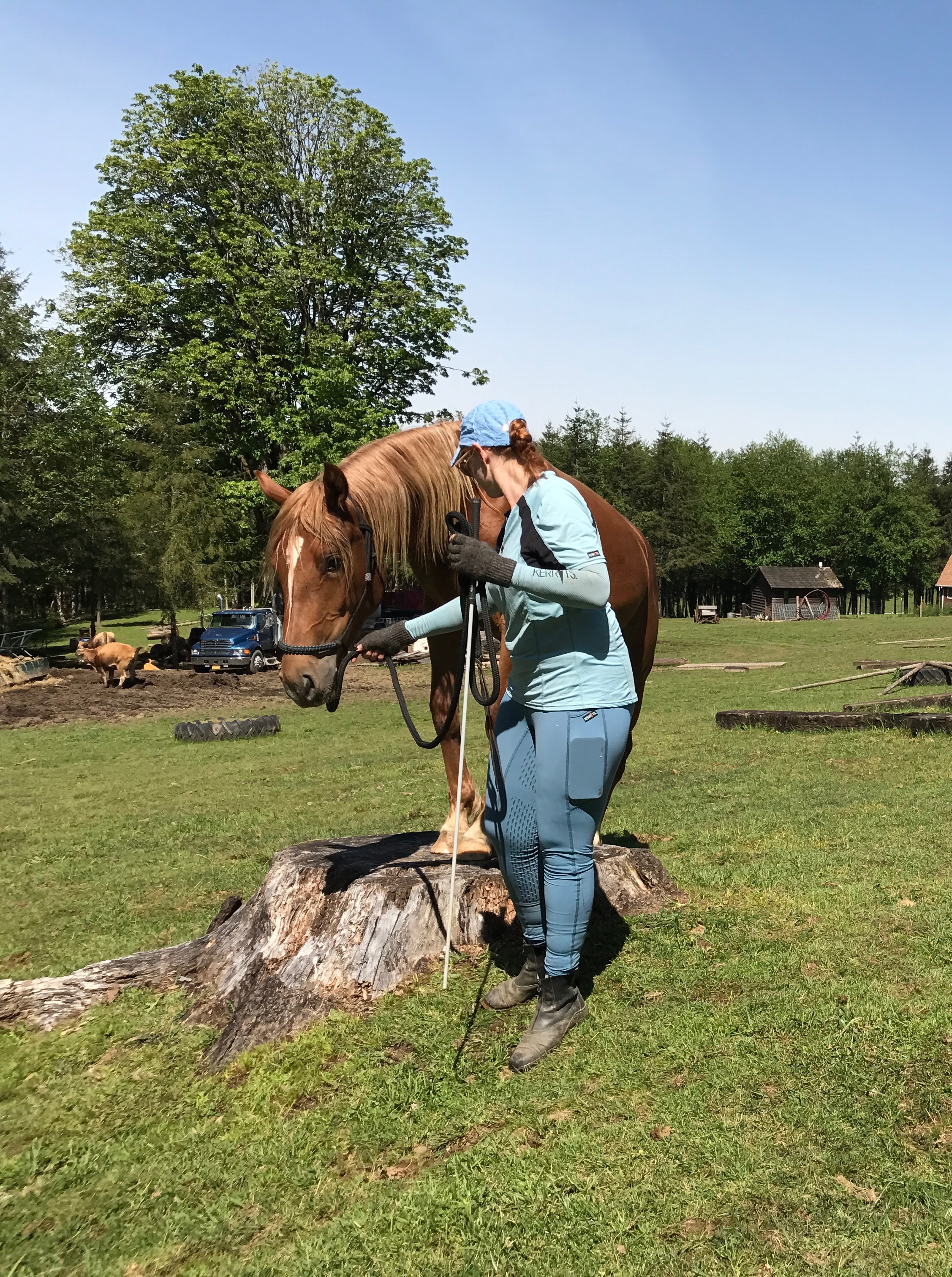
Student and her 2 yr. filly starting to talk about precision.
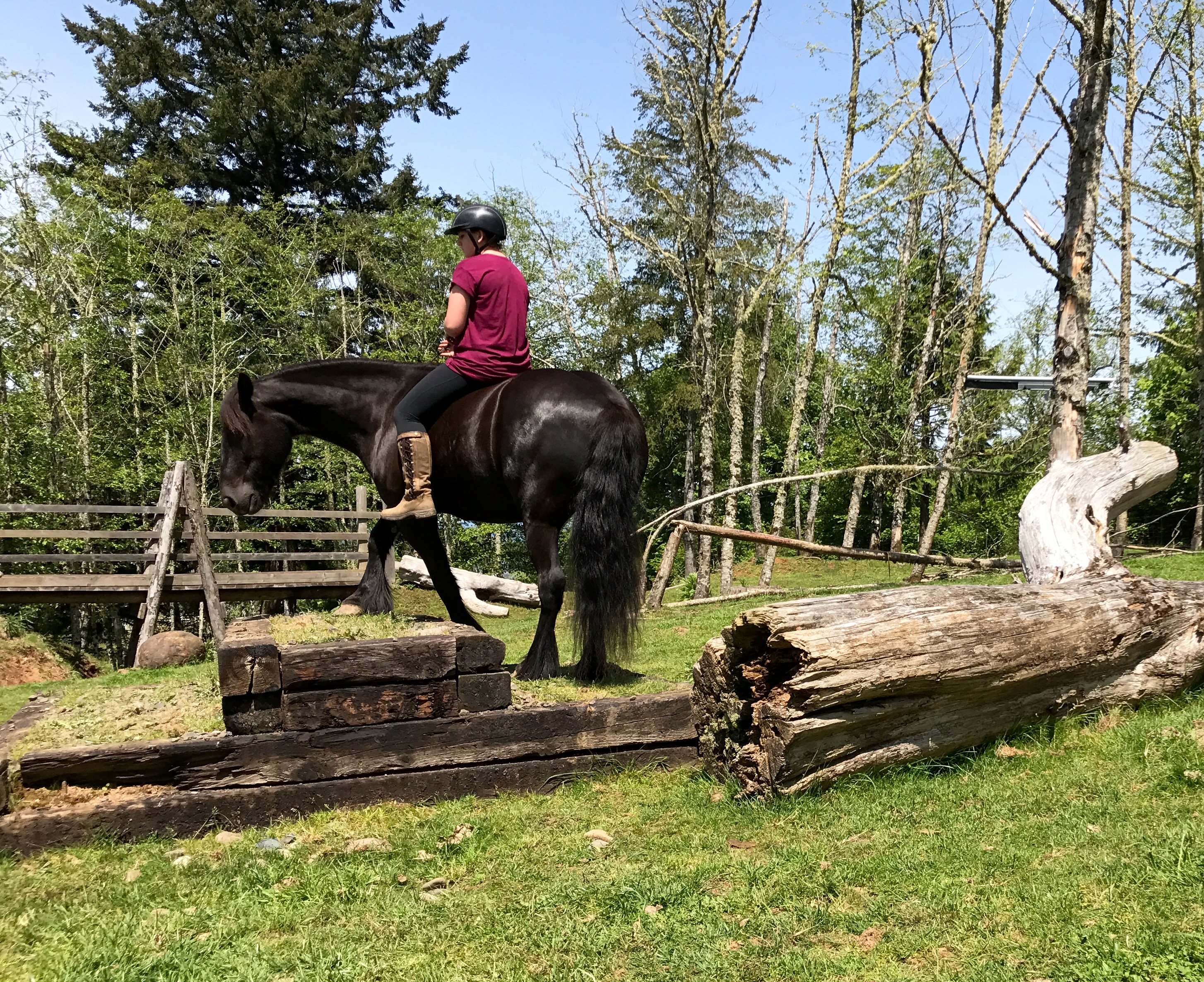
This advanced obstacle horse is able to precisely position his feet and body in order to change direction in a tight space that involves elevation changes.
_________________________________________________________________________________________________________________________________
What's the Rush?!
May 2017
Asking before they are really ready.
The best teachers know the individuality of their subjects and how to help them find their way. A common goal for many riders is having the horse move forward in the different gaits with focus, cadence, balance, and good self carriage. We often see horses moving effortlessly when at liberty and unencumbered by a rider. It's a completely different dynamic when asking the horse to figure it out while carrying a rider. Want to add another layer of complexity? Ask them to do it open air out on a trail, while climbing a wooded hill or passing a herd of cows in a field. Often, the rider/teacher's approach is too simple minded or hyper focused on one aspect of the gait not realizing just how many stars need to align for the horse to gain mastery.
Take the trot for example. When talking about a horse starting under saddle, when is it ok to ask for the first trot? I see videos of other trainers starting horses and having them trot and/or canter within the first few rides. Riding with a lot of 'feel' and trying to be as intuitive as possible, I've never gotten any signals from a horse telling me they were ready to do anything but walk in the first few rides. As a matter of fact, for us, picking up a faster pace/gait may not happen for weeks. Why? Because, for the horse, the experience of carrying a rider is multi-faceted and complex. Starting the young horse involves a commitment to proper development of communication, thinking, physical strength, balance, coordination, confidence, and attitude. I find the best way to truly achieve all those development goals is by adding to the skill set in small bits, waiting for a certain level of mastery before adding more. For a green horse, switching from walk to trot or trot to canter tends to draw more flight brain, reactive behavior and limits thinking, problem solving behavior. Before I start working at a trot, I want to know I have a horse that is approaching mastery of thinking, solving problems, stopping, responding to leg & seat in a variety of situations.
The best first moments of trotting have always happened in an open, natural setting with a horse that already has a lot of navigation experiences at a walk. In the beginning, I want the horse to focus on confident moving forward, understanding my movement & balance and melding it with theirs. I keep a relaxed rein, don't worry about frame or head-set, and posting with good balance.
When you begin to realize you are developing a sentient being and not a machine, you slow down, get more thoughtful, and take the time needed.
________________________________________________________________________________
Get Grounded Foundation
April 2017
When I decided to embrace the concept of 'eye level work' and abandon the mainstream mindset of 'ground work', the whole concept of laying a foundation just blossomed. For many, 'ground work' is about practicing mythical notions of achieving respect, with methods that give the handler permission to be disrespectful. There is often this notion that we must desensitize, disengage the hindquarters, move their feet, flag 'em, tarp 'em, tap'em, and round-pen 'em into the ground. So many are convinced that these practices will magically build a trusting relationship that prepares the horse properly. Over the years, I find myself trying to move farther and farther from these busy bee notions. The discovery that my suggestions to the horse, my 'asking' can be subtle and free of irritations, of vibrations, and more importantly of an egotistical notion that success is found in displays of subordination have led me to a place of less conflict. For me, working at Eye Level comes from a mind-set that honors an apperceptive creature who beholds an impressive level of cognition. I feel responsible to show the horse I am a sensible, thoughtful, and respectful partner that seeks to have peaceful and meaningful experiences with them. When your mind shifts from, "make them do it", to "help them understand", your whole approach changes. We found the best way to begin the journey, to set the best foundation is navigation at Eye Level. Hiking on the trails allows us to build rapport, give them the concept of navigating together, problem solving together, and starts the flow of communication. I have found no better way to begin the dialogue, to help us both figure each other out, to figure out our bodies and how to work together. I have yet to find a horse that didn't appreciate this approach.
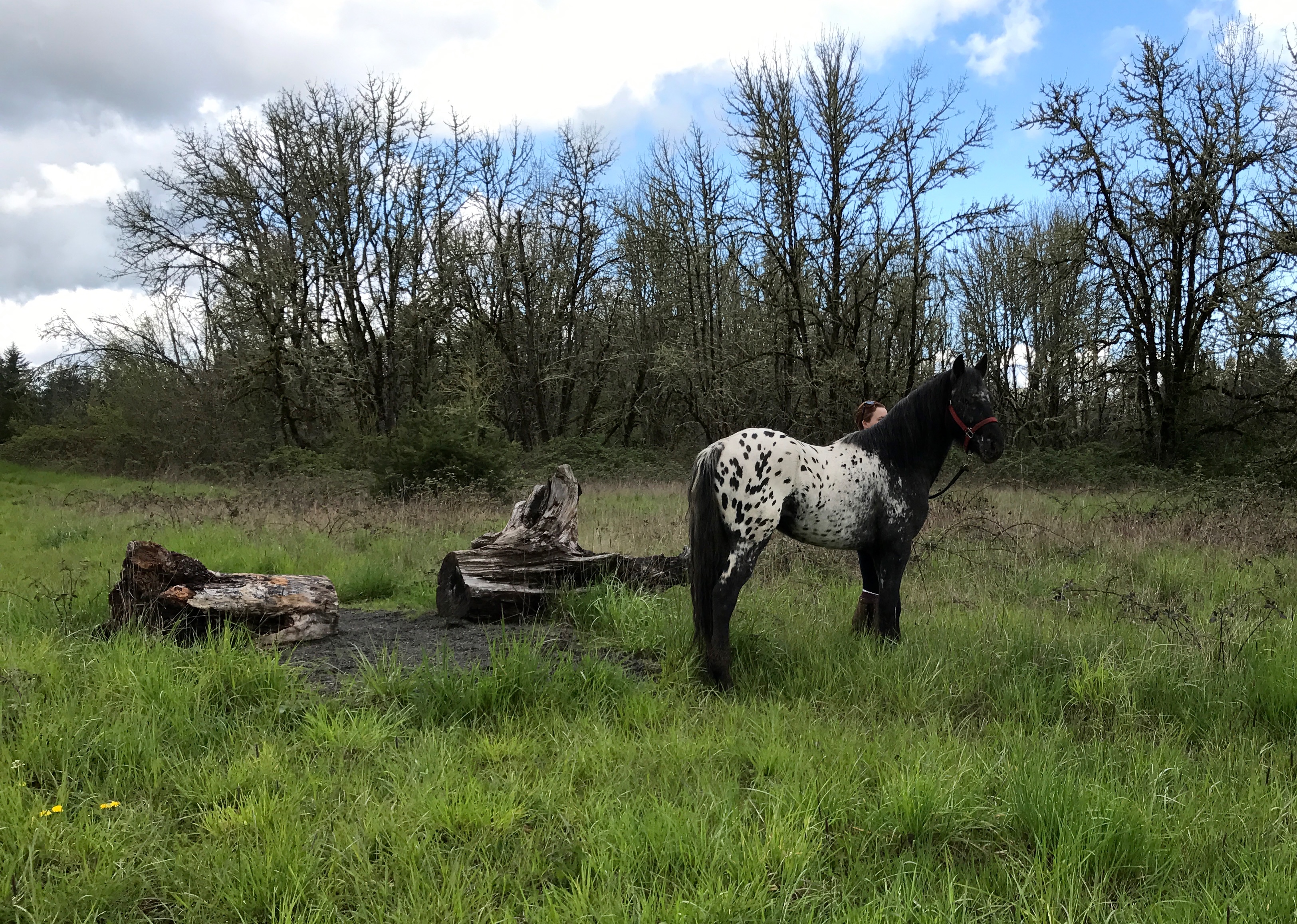
FiddleHead Flit is approaching 3yr. and has begun his eye level foundation training. He will cover a lot of ground hiking on trails with us, providing opportunities to dialogue, problem solve, and overall develop the mind and body.
________________________________________________________________
Wait, Let Me Get Comfortable With That
July 2016
When your focus shifts from forcing them into a box to truly wanting to help them understand, you are able to slow yourself way down. Too often, the horse becomes a victim of our agenda rather than given the time they need to progress. Every horse has concerns and seeks to understand. Every handler needs to constantly fine tune and develop his/her listening skills with horses in order to properly strategize a suitable way to help them understand. I absolutely love this process of developing creative strategies that are fun and honorable.
This gelding came with concerns about quick movement and activity around his hind end. We knew we needed to take the time necessary to help him get over his guarding and bracing before proceeding with long line work. After several hiking sessions and building rapport, we moved to several sessions of tag team where one handler led and a second person would come up behind with intent to give rubs & scratches. The photo is showing the next step, where the gelding was allowed liberty to move. We used a favorite food in a feed pan to create a positive association. Mouth movements associated with eating help release tension. Naquel performed all sorts of free movements, approaching and retreating. This gelding learned quickly that the concerns, guarding was no longer necessary.
_________________________________________
Ask, Then Wait
August 2015
Horses don't have a symbol system or language like we do. This means, understanding and identifying the world around them is a different process. Where we rely mostly on sight and a visual symbol system....labeling things quickly with words, horses use all of their senses (sight, hearing, smelling, touching) to help them understand the world around them. Navigation with a young/green horse is about exploration and gaining understanding of the world beyond the 4 corners of their fence. As the rider, we often want forward faster than they can deliver. When a horse loses forward or looks for another option than what you are asking, it is very tempting to label them 'stubborn', 'lazy' or some other unpleasant moniker. More and more I am discovering the peacefulness & benefits of waiting for the horse to move forward out of understanding vs. my pressure and force.
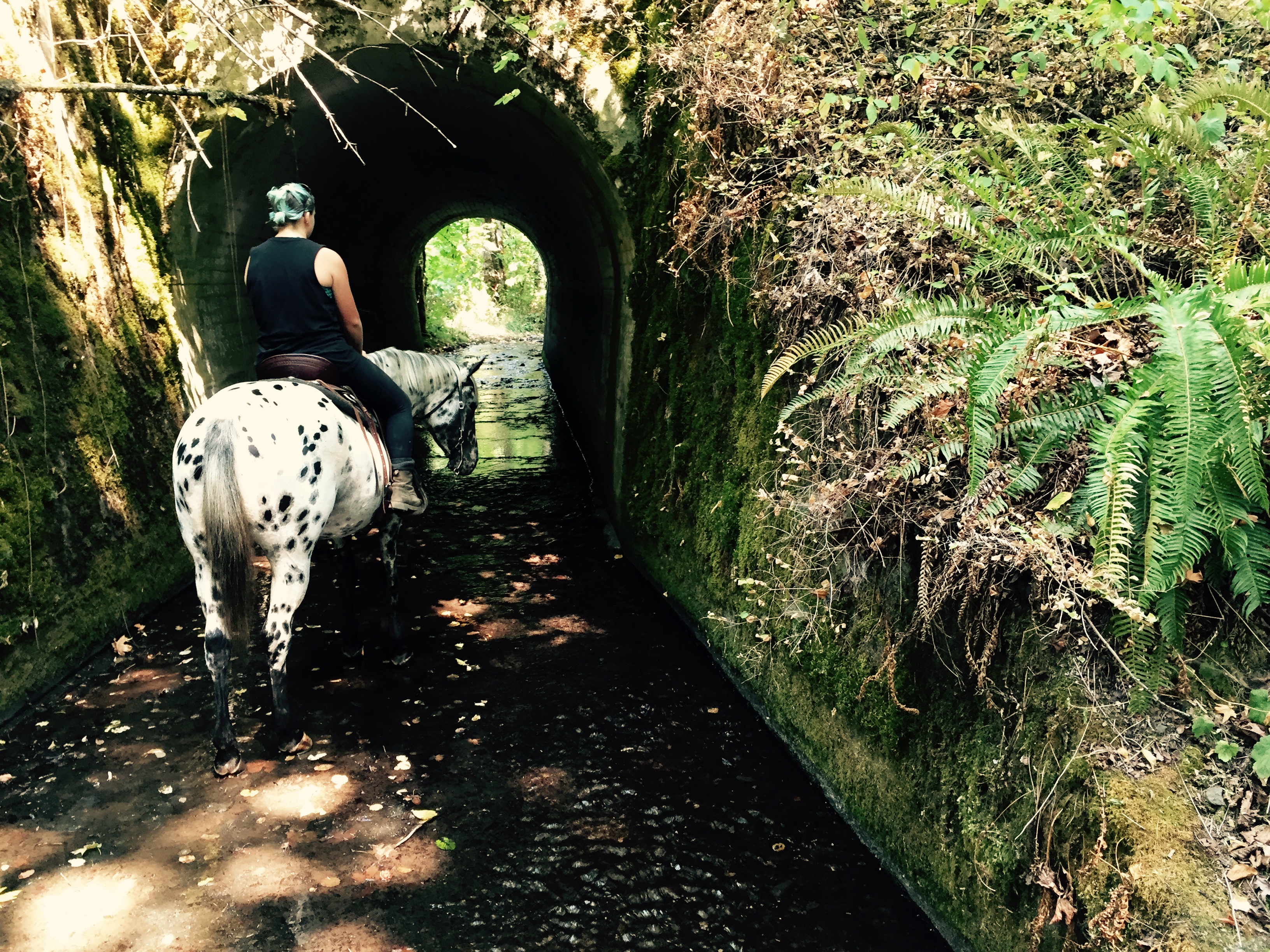 __________________________________________
__________________________________________
Get Grounded Mentorship Method
June 2015
The ability to learn and focus is greatly related to stress. We have found that minimizing stress for the newly learning horse maximizes their ability to absorb & learn new things. Over the past 2.5 years, we have developed our foundation training in a way that utilizes equine mentors for the horse in training. Being a herd animal, of course they are geared to be focused on each other and concerned for each other's whereabouts. The process of taking one away from the others and asking him/her to focus on all of the new stuff we lay out is a BIG DEAL! It takes time for the horse to develop focus, trust and confidence on their own and away from others. We have decided to make that request a slow transition.
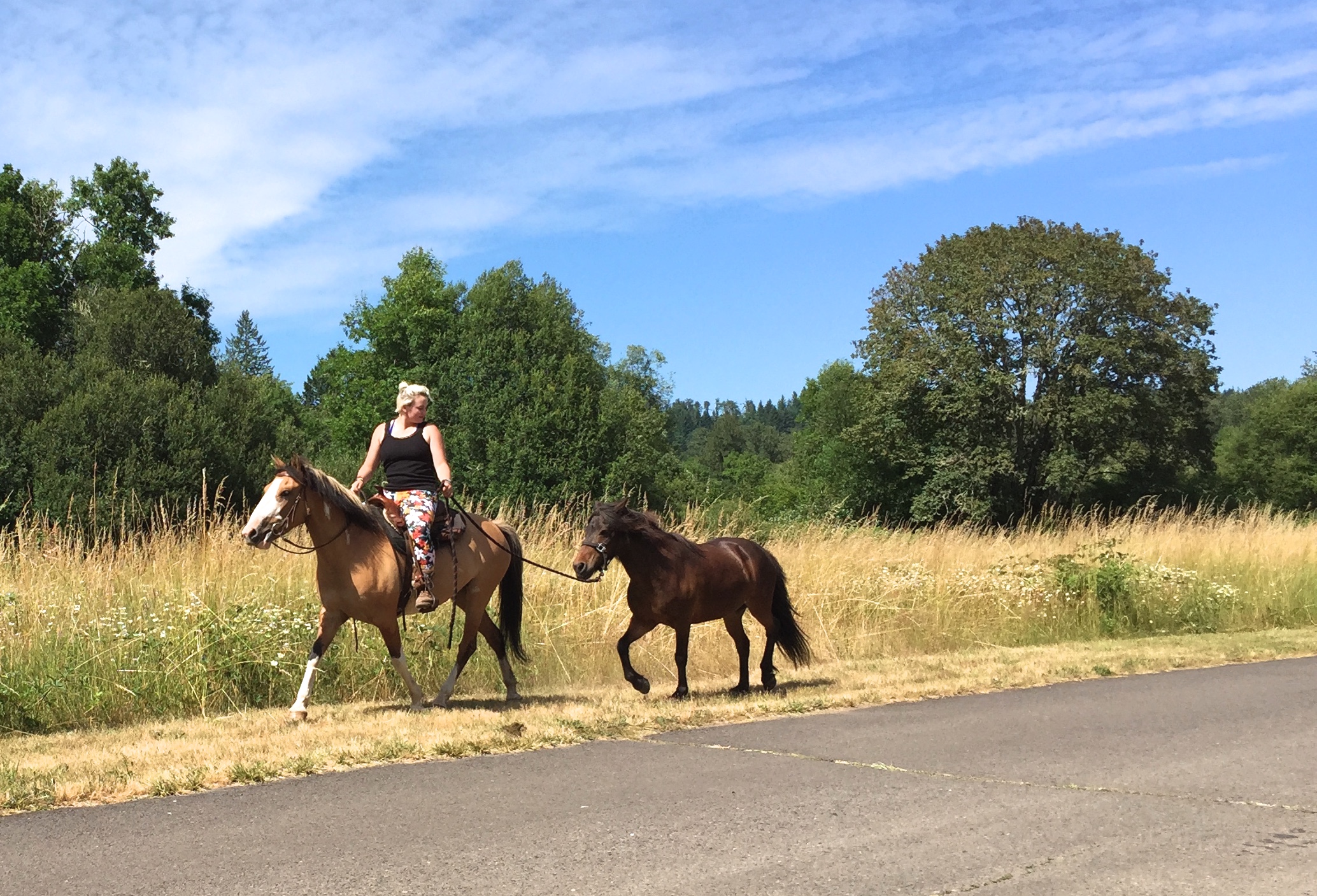
Ponying on the trails helps develop the horse physically and mentally.
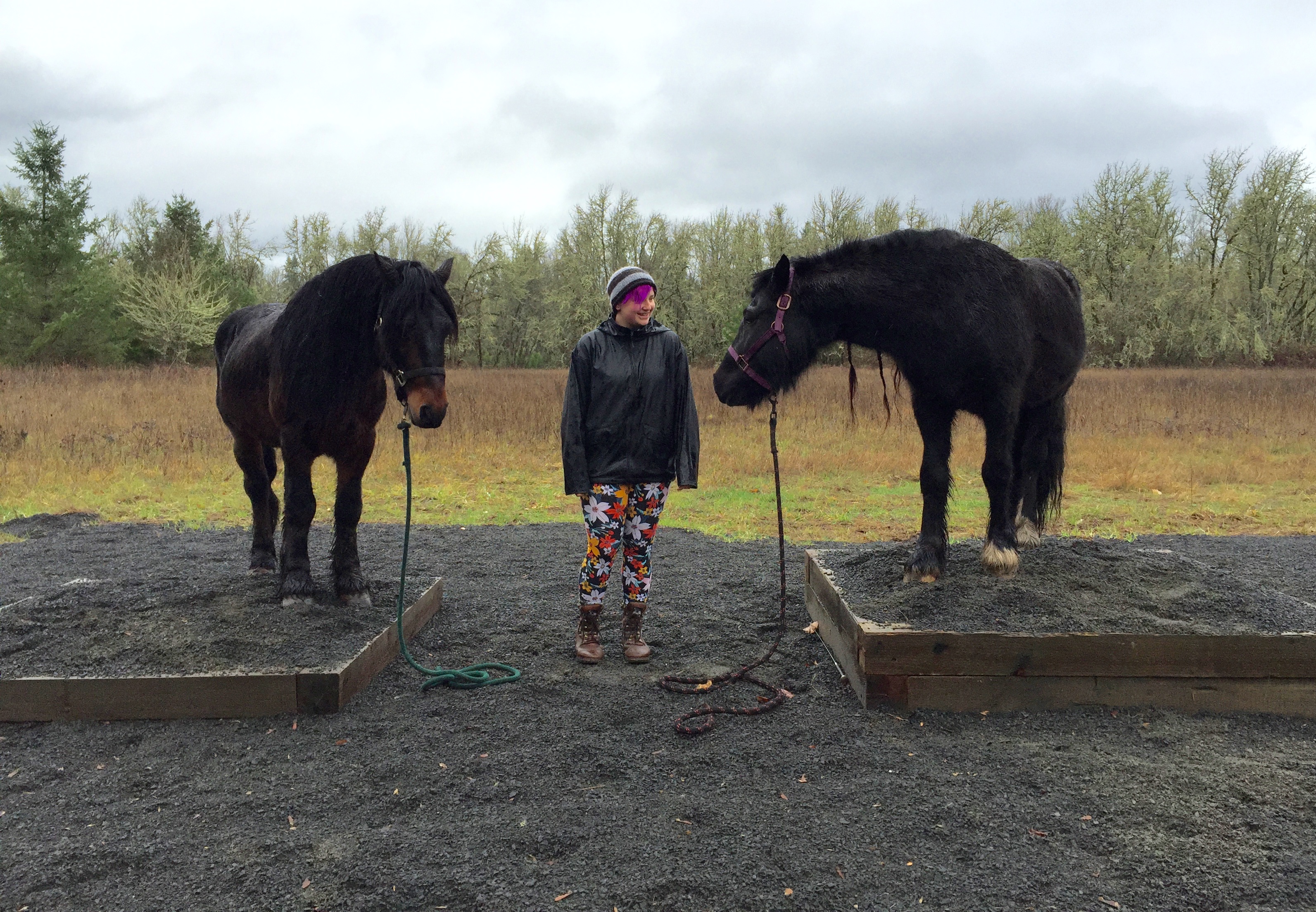
The horse on the left is present during a hike/obstacle groundwork session to help assure the horse on the right.
Below is a video where I work with 2 horses together in the arena. The black horse is the mentor and the appaloosa is experiencing the obstacles for the first time. In the beginning, he is just present. Then we work together as a group.
The Individual Needs of the Learning Horse
May 2015
The gypsy mare in the following video has been in saddle training for almost 4 weeks. Her personality is more sensitive than most of the draft horses we have worked with. She has needed extra time to understand the movement & actions of humans and has been slower to believe their intentions are harmless. Moving with a human on her back had resulted in 3 episodes of panic with an urge to bolt. Clearly, this mare was telling us she needed smaller bites on her plate at a time. I absolutely love the creative process involved in helping a horse understand the world we have invited them to join. This mare has worn on her shoulder this huge thing that we ask of horses, and has softened me to appreciate how hard they try for us, despite what they often feel intensely inside. In this video, we are asking her to take the confidence of what she knows and add to it by being brave....dealing with the 2nd human who is behaving in an unfamiliar way. You can see her literally trying to solve it on her own by wanting to get away. The driver keeps quietly asking her to be brave, which she finally does.
Here is Izzy at week 6, still not ready to ride, but doing well with long line work open air on trails w/out any horse buddies.
___________________________________________________________________________________
Naughty Pony or Responsible Leader?
The black horse (Bing) on the left can teach us something about responsible leadership. The 3yr. mare on the right is newly introduced and will spend a few days in an adjoining pasture until she is welcome to join the others. She is confident and Bing has taken on the job of making sure she understands listening, yielding and respect. He does this by keeping an eye on her movement. If she gets close to the fence-line, he postures for her to move. He will continue to do this off and on for the next day or so until he is satisfied that she understands. A horse that does not pay attention and listen to the leaders is a liability. Bing is also giving this mare security by demonstrating his command. Horses need to know their leaders are strong, brave and willing to take charge. Bing never abuses or irritates to get the respect he deserves. He just shows his confidence and his strength.
I love sharing the benefits of horse hiking on trails with others. Three friends set out with me to some of my favorite equestrian trails at Elijah Bristow State Park. Finding tasks and obstacles was no challenge on this day as a recent ice storm left lots of branches, debris, and mud puddles. There were a few spots where the trail was completely blocked and we had to thoughtfully find a way to get through. The horses had to be calm and attentive as we directed their steps, sending them through while we were stepping on this branch and holding up that one. Spending this time is one of the most rewarding things to me, and seems to always put me in such a satisfying place of connection with my horses, nature and people.
Rapport Test Fell Stallion
First Long Line Drive Open Air with Social Temptations
January 2014
Until June 2013, Copper's main job was breeding. He, by nature, has a fabulous temperament being very respectful and is able to pasture breed with no issues. I'm so tickled to be able to expand this guy's horizons and provide all sorts of other experiences for him. Copper loves attention, to be doted on and do anything social. I think he is also enjoying having jobs and tasks to do. He has a strong social drive and I want to fill that need for him. But the question today was, will he still listen to me in an open air environment and control his strong social drive? This test did not just come out of the blue, but in context of a building relationship that he and I have where there is an established protocol between us. Getting Grounded is about setting them up for success and that is a responsibility I keep very seriously. I knew I had enough rapport established with him that he would be motivated to try his best for me. I used a snaffle bit because I wanted the motivation to be about our rapport rather than about leverage. I also have provided ways for him to be socially enriched on a daily basis by giving him a paddock buddy, turn-out time with others, and taking him on group trail rides. I also knew, that if he tried to pull something, I had three mares on the other side of that fence who would put him straight in his place.
So we jogged together in circles and reversed directions, stepped over some logs, stopped and backed and did a little hanging out. On one of our breaks, I look over at the Appy mare and she is squirting and winking. I let Amy Jo know, who was taking photos, "it could get silly"…..trying to stay positive. A few more jogs around and the horses decide to take off out of sight. Copper turned in their direction and clearly wanted to go too. I asked him to 'ho', had to firm my hands a bit, but he did! We walked calmly away to the gate, backed through the gate on the lines, and headed back to the paddock. It wasn't all pretty, and he got high headed at moments, but I am pleasantly proud!
________________________________________________________________
Learn & Train
Fostering long term relationships.
January 2014
Nothing makes my day better than meeting someone who has a drive and passion for the presence of horses. But having the drive and passion is not enough for a successful working relationship with a horse. There has to be knowledge and understanding. Onnie (above) has picked Victor (left) to be hers and has visions of the two of them riding off into the sunset together. But, sometimes our dreams don't come in an instant and Victor first needs to learn how to carry a human, to be safe, and to become a rock-solid riding companion. My concern is for Victor, to be in a long term loving home where he is treated with respect and taken care of. I'm so thankful that Onnie has chosen to be a participant in Victor's training. She comes 3 days a week to observe and lend a hand wherever she can. Today, I ponied Victor w/ Copper and Onnie rode along on Bing. Getting Grounded rule #1, set them up for success. I hope Onnie's willingness to be patient and participate will give her and Victor a lifetime of just that, success!
______________________________________________________________________________________________________________
Dominance is Not Leadership
November 2013
Being able to dominate another does not mean you are a good leader.
A lot of prep work went into making this green horse's 11th ride a positive and meaningful experience. And most of that prep work happened on the ground: in-hand obstacles, hiking, and long line driving. This 3yr. old is having a lot of first experiences with humans and we don't take that journey lightly. This is because we are aware of how a herd animal's brain works. There is an understanding that they are looking for leaders who don't necessarily dominate, but keep them safe. Often times, when people train or work with horses, their perspective is "I am going to make you do this". There is often very little consideration of the physical and emotional readiness of the horse. The mare above has done obstacle work, but never been on this particular course or any course with such complexity. She is standing in an obstacle that requires a high level of willingness and trust in the leader. This is because the water box in itself is mysterious to the horse. This particular water box has an added element of movement as it contains a floating piece of plywood that creates a weird sinking feeling when stepped on. She is standing there quietly because she understood our communication and she knew we would keep her safe. We did not dominate her into it.
_____________________________________________________________________________________
Proud to be on the Ground
Getting at Eye Level

Today I pulled Victor (foreground) out of his almost 6 month hiatus with a small herd on 15 acres. Victor spent about 60 days earlier in the year doing some unique liberty and obstacle training. He had been hiked and had obstacle/ground work as a weanling, but presented in a very casual and fun way. I effortlessly walked Vic away from his pasture mates, loaded him in a trailer and took him to a new barn to prep him for a hike with a new friend that I wanted him to meet. At the new barn, we did some clipping and grooming…..then headed off for our hike. Aside from being a silly 2 yr. old a few times, Vic remembered all of his training. He remembered to pay attention to me as his leader and to watch for my body language/cues. Trailer ride by himself, new barn, new trail….and he was safe and calm the whole time. He did everything I asked including backing over a bridge. When we made it back to our trailer, we met two nice ladies getting ready to head out for a ride. They asked us why we were walking the two horses. Spending time on the ground with a horse reminds me of those moments when we take time to bend down and get at eye level with a child. I do it because each horse deserves our individual understanding and it improves their understanding of us. The time we spend at eye level is the foundation for a trustworthy, safe, and satisfying partnership.
_________________________________________________________________________________________________________________________________
Setting Them Up For Success
This is Lydia, 3yr. Fell mare with 4 short rides on her record. I took Lydia and her pasture mate to a new facility that had an obstacle course and cows enclosed in about a 1 acre pasture. I never have a training session with a horse without first creating a plan. Planning involves establishing what I want to accomplish with the horse and thinking about how I will handle any common 'what ifs' that the horse may come up with. For Lydia, I wanted her to have a good positive experience being taken away from her home. I wanted to show her that she can find security with me in the structure I lay out for her. I'm still getting to know Lydia, so I definitely wanted to create a way where she could really tell me some things about herself: how she responds to a new environment with unfamiliar objects, how she sees or interacts with me when she is at liberty and off lead, and what is most interesting to her. I also wanted to see if anything concerned or confused her. In the Getting Groundedsm method, I call this time taken to observe behavior "getting a read".
After the three of us entered the fenced area, I let Lydia loose to roam about and explore. I kept the other mare, Margy with me and proceeded to do some groundwork with her over the obstacles. Lydia immediately took off very boldly and headed for the cows. Once she figured them out, she proceeded to check out most of the obstacles on the course. As I am working Margy, I constantly check to see what Lydia is up to and what she is doing. Letting Lydia have this time directing her own experience and me being able to observe it was priceless. It gave me so much information about who she is. Lydia not only boldly approached a lot of obstacles, she would often enter the obstacle to explore it further. She went right up to both a cowboy curtain and a animal hide hanging from a tree, touched and smelled both of them. She even went inside a small structure that contained a tarp covered mattress that she stepped over with great confidence. Lydia would come back to check with us, but was very eager to head away and explore. Then she grazed a bit, and then she decided to engage the horse standing in an adjoining pasture. Lastly, Lydia headed to a congested area with lots of objects and a stock tank. She showed signs of concern here and her body language told me that we would not work much in that area. Working Lydia in a spooky situation is not something I will avoid forever. For today, it did not fit into my plans or what I wanted to accomplish with her.
Lydia's formal session with me that day consisted of first forward motion through a lot of the obstacles. Then we focused on stopping, yielding shoulders and haunches, and backing with the obstacles. We finished with some nice long-line work. My approach and willingness to take the time to 'get a read' on Lydia made for one of the best training days!
_______________________________________________________________________________________________________________________________
Getting to Know Your Student
This 2 yr. filly came to us with very little information about her background. We use a round pen, short lunge, and obstacles to help us assess the mind-set of an unfamiliar horse. First, lunge at the walk on a long lead. We want to know if the horse has any understanding of human body language. Does she know to yield when asked? And, if not, how quickly will she learn to yield? After this we will start lunging off-lead in a round pen, usually for several days. Our short goal is to be able to take her out of an enclosed area and work with over obstacles. Introducing a horse to a variety of objects and obstacles is a great way to get to know the horse. Through the use of obstacles, you can gather information such as coordination level, willingness, attention span, fears or concerns, and level of respect for humans.
Naquel is using lunge line and obstacles to gather information about this horse.
_______________________________________________________________________________________________________________________________
Respecting Concerns
This image was taken during Margy's 28th ride. Margy had told me several rides earlier that she had concerns about things that move under her feet. Margy was very willing to approach this teeter totter, but very resistant to step or walk on it. I asked with clear communication several times while riding. You can see here, her confidence in what I was asking was lacking. My whole attitude and mindset was, "I'm going to help you get more confident about this". In a situation like this, known as the refusal, it is important to stay positive and keep from getting frustrated or angry. Knowing Margy, once she has repeated positive experiences, she will be fine. In this dilemma, I have to take an assessment moment where I do some planning. Initially, my goal was for her to walk across the teeter totter end to end. When I get a refusal with a green horse, I switch to 'baby steps' mode. This means I set a bunch of little goals that eventually can all be sewn together. Confidence comes with asking for something attainable and letting the horse know when they got it right. I knew dismount and get at eye level was the key to her confidence.
It is very common for a horse to get confused or unsure about a task. We often get at eye level with a horse to help it gain the confidence and understanding he/she needs.
______________________________________________________________________________________________________________________________
Reinforcing Worthy Leadership
Horses can handle deep seated fears if they have learned to trust and follow the direction of their human leaders.
This mare has a phobia of cow-hides. It was like she had a deeply gauged groove in her brain about how to respond when she was in the presence of one. A scar on her shoulder indicated to me that she had experienced some kind of trauma when she was younger. Based on her research, Evelyn B. Hangii, MS, PhD of the Equine Research Foundation gives insight into the long term memory of horses. According to Ms. Hanggii, there are two significant ways of setting something into the long term memory of a horse. These two main ways are fear or repetition. At some point in her past, a traumatic experience put panic into her long term memory. I knew the only way to teach her some sensibility was through repetition.....drawing appropriate responses to a variety of experiences.
Hiking with this mare and obstacle groundwork were used extensively to build confidence and trust. This mare understood her leader and knew she could be kept safe in a variety of environments. By establishing a protocol, the mare found security. Did this type of work take away her fear of cowhides? It did not. But through hours of working on the ground, the mare had learned how to behave and respond safely and appropriately in the midst of something she is very afraid of.
